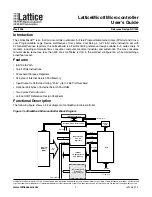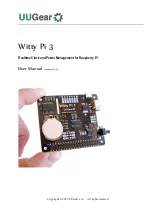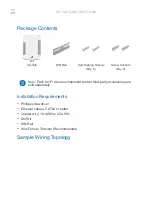
PM410-00121R18271
nv
Niko
sa Industriepark West 40, BE-9100 Sint-Niklaas, Belgium — tel. +32 3 778 90 80 — e-mail: [email protected] — www.niko.eu
EN
410-00121
5
3. Wählen Sie, falls gewünscht, einen anderen Modus aus, indem Sie wiederholt kurz die Programmiertaste
drücken. Der Modus wird mit einer blinkenden Status-LED angezeigt (Abb. 1
➏
).
Modus
Lichtsignal Status-LED
M1
M2
M3
4. Betätigen Sie nacheinander die Bedienungen, die mit dem Empfänger in einem bestimmten Modus
zusammenarbeiten müssen. Die Bestätigung einer korrekt empfangenen Adresse wird durch eine
lange Leuchtzeit angezeigt (4 Sek). Es reicht aus, 1 Taste pro Bedienung zu drücken. Das Verhalten
der anderen Tasten wird nämlich automatisch dem gewählten Modus angepasst (z. B.: im Zweitasten-
Modus wird die Taste ober- oder unterhalb der gedrückten Taste automatisch als zweite Taste
ausgewählt). Wenn Sie versuchen, mehr als 15 Bedienungen zu koppeln, wird die Status-LED (Abb. 1
➏
) zu blinken beginnen.
5. Sie können die Programmierung beenden, indem Sie die Programmiertaste (Abb. 1
➎
) wiederholt drücken
(< 1,6 Sek.), bis Sie den Programmiermodus verlassen haben. (Modus 1 - Modus 2 - Modus 3 - AUS)
3.3. Funkschalter entkoppeln
Durchlaufen Sie die folgenden Schritte, um einen Funkschalter gemäß dem Easywave-Protokoll vom Controller
zu lösen.
1. Programmiertaste etwas länger drücken (> 1,6 Sek.) (Abb. 1
➎
). Die Status-LED (Abb. 1
➏
) blinkt wie
folgt:
2. Drücken Sie eine beliebige Taste der Bedienung, die Sie entkoppeln möchten. Die Status-LED (Abb. 1
➏
)
leuchtet ununterbrochen für 4 Sekunden. Danach beginnt sie wieder, wie folgt zu blinken:
Wiederholen Sie diesen Schritt für jede zu lösende Bedienung.
3. Drücken Sie die Programmiertaste kurz (Abb. 1
➎
), um den Programmiermodus zu verlassen.
3.4. Controller in Werkseinstellungen zurücksetzen
1. Programmiertaste etwas länger drücken (> 1,6 Sek.) (Abb. 1
➎
). Die Status-LED (Abb. 1
➏
) blinkt wie
folgt:
2. Programmiertaste nochmals länger (> 1,6 Sek.) drücken (Abb. 1
➎
), um alle gekoppelten Bedienungen
aus dem Speicher des Controllers zu entfernen. Die Status-LED (Abb. 1
➏
) leuchtet ununterbrochen für
4 Sekunden. Danach beginnt sie wieder, wie folgt zu blinken:
3. Drücken Sie die Programmiertaste kurz (Abb. 1
➎
), um den Programmiermodus zu verlassen.
4. VERHALTEN ERROR-LED
Die Error-LED (Abb. 1
➐
) blinkt rot, wenn der Controller in den Fehlermodus übergeht. Mögliche Fehlermodi
sind: Überlastung, Überhitzung oder Kurzschluss am LED-Streifen.
5. TECHNISCHE DATEN
Abmessungen
176 x 62 x 36 mm (HxBxT)
Frequenz
868,3 MHz
Maximale Funkfrequenzleistung
10 dBm
Maximale Leistung pro Kanal bei Eingangsspannung 12 Vdc
50 W
Maximale Leistung pro Kanal bei Eingangsspannung 24 Vdc
100 W
Maximaler Strom pro Kanal
4,2 A
Leitungskapazität
1,5 mm² – 2,5 mm²
Max. Umgebungstemperatur
45 °C
Schutzart
IP20
Kennzeichnung
CE-Kennzeichnung
6. CE-KENNZEICHNUNG
Dieses Produkt erfüllt alle anwendbaren europäischen Richtlinien und Verordnungen. Für Funkgeräte
erklärt Niko NV, dass die Funkgeräte in dieser Anleitung der Richtlinie 2014/53/EU entsprechen. Falls
zutreffend, kann der vollständige Text der EU-Konformitätserklärung auf www.niko.eu eingesehen
werden.
7. VOR DER INSTALLATION ZU BEACHTENDE WARNHINWEISE
Die Installation von Produkten, die dauerhaft zur elektrischen Anlage gehören werden und gefährliche Spannungen
enthalten, muss gemäß den geltenden Vorschriften von einem anerkannten Installateur vorgenommen werden.
Diese Gebrauchsanleitung muss dem Benutzer ausgehändigt werden. Die Gebrauchsanleitung ist den Unterlagen
der elektrischen Anlage beizufügen und muss auch eventuellen neuen Besitzern ausgehändigt werden. Zusätzliche
Exemplare erhalten Sie über die Website oder den Kundendienst von Niko.
8. UMWELT
Sie dürfen dieses Produkt oder die mitgelieferten Batterien nicht über den normalen Hausmüll
entsorgen. Bringen Sie Ihr ausgedientes Produkt zu einer anerkannten Sammelstelle. Genau wie
Hersteller und Importeure spielen auch Sie eine wichtige Rolle bei Sortierung, Recycling und
Wiederverwendung von ausgedienten elektrischen und elektronischen Geräten. Um die Abholung
und Verarbeitung wiederverwertbarer Abfälle finanzieren zu können, ist im Verkaufspreis oftmals
bereits eine obligatorische Recyclingabgabe enthalten.
9. NIKO KUNDENDIENST
Haben Sie eine Frage oder ist das Produkt defekt? Nehmen Sie Kontakt mit Ihrem Großhandel oder dem Kundendienst
von Niko auf (Belgien: +32 3 778 90 80) oder lesen Sie die Rubrik „Hilfe und Beratung“ auf www.niko.eu.
10. RECHTLICHE HINWEISE
Niko stellt seine Anleitungen mit größter Sorgfalt zusammen und bemüht sich, diese so vollständig, korrekt und
aktuell wie möglich zu erstellen. Dennoch sind etwaige Unvollkommenheiten nicht ausgeschlossen. Niko kann
diesbezüglich jedoch, im Rahmen der gesetzlichen Grenzen, nicht haftbar gemacht werden. Unvollkommenheiten
in Anleitungen können dem Kundendienst von Niko stets unter [email protected] gemeldet werden.
EN
Read the complete manual before carrying out the installation and activating the system. Keep the
manual for future reference.
1. DESCRIPTION
The 4-way channel controller is designed to control 12 to 24Vdc LED strips (common anode). The controller
has a maximum power of 50W per channel for 12Vdc LED strips and of 100W per channel for 24Vdc LED
strips. The controller can control the following types of LED strips: RGB, RGBW, tunable white and monochrome.
To control more than 4 channels synchronously, up to 10 controllers can be connected together in a cabled
master/slave configuration.
One master controller can be controlled by maximum 15 wireless Niko wall controls in accordance with the
Easywave protocol. One wall control can control an unlimited number of 4-way channel controllers (in master
mode) simultaneously. Depending on the number of buttons on the selected wall control, you can link the controls
in 3 different modes (see table in § 3.1). We recommend using the specifically designed RGB(W) wall controls
(article numbers 410-00002 + xxx-90002) for controlling the colour LED strips.
This product is part of the Niko radio frequency system (RF) according to the Easywave protocol, a wireless
installation technique between the push buttons (control points) and the controllers to be operated. The remote
control or wireless control operates on the basis of signal transmission via radio waves at a frequency of 868
MHz. Only products that do not continuously transmit are permitted at this frequency. The wireless system is
therefore perfectly suited to specific applications, such as the renovation of classified interiors and the expansion
of existing electrical installations (where drilling or channelling work is difficult or not possible).
The operation of devices with an IR remote control, such as a TV or video and audio devices, is not disrupted
by the RGB(W) wall control. The indoor range is ± 25m in optimal conditions. The transmission range of the
RGB(W) wall control depends on the materials used in the residence. Figure 2 shows the loss of the transmission
range depending on the materials used.
Caution:
The signals of this wireless device can be disturbed and impair the proper functioning of the system.
For this reason never place this device in the neighbourhood of other wireless devices and test the operation
and the range of the wall control and controllers in their intended positions before installation.
2. INSTALLATION
2.1. Mounting
The controller is suitable for mounting in suspended ceilings, furniture, roller shutter cabinets ... You mount
the controller in openings with a drill diameter of minimum 60mm and an flush-mounting depth of minimum
170mm (see figure 3).
The controller has four mounting holes for wall mounting (hole diameter: 4mm).
Caution:
• Never place the controller close to its power supply to prevent heating and potential disruption of the RF signal.
• Optimal cooling is required for proper functioning of the controller (see figure 4).
• Never cover the controller (see figure 5).
• Metal or heavily reinforced concrete substrates can disturb the RF signal.
Tips:
• Configure the dip switches
(see figure 1
➍
)
on the product correctly before mounting the controller (see § 2.3)
• Test the proper functioning and the range of the wall controls and/or controllers in their intended position
before installation
• Place the wall control and the controller as close as possible to each other but respect a minimum distance
of 50cm.
2.2. Connections
Always use wires with a diameter of 1.5mm² or 2.5mm² for connections at the PRI side.
2.2.1. Power supply (see figure 1
➊
)
Connect the power supply to the PRI side of the controller (see figure 6).
Only use a power supply with a voltage and power suitable for the connected LED strips. Niko recommends LED
power supplies with article number 340-0002x or 340-0005x.
2.2.1 Slave(s) (see figure 1
➋
)
Connect the master with the slave(s) via the terminals D1+, D1-, D2+ and D2- following the wiring diagram
in figure 6.
2.2.2. LED strip(s) (see figure 1
➌
)
Connect the LED strip(s) to the SEC side of the controller.
• RGB(W)-LED strips: (see figure 6)
- red on the R – WW connection terminal
- green on the G – CW connection terminal
- blue on the B – WW connection terminal
- (white on the W – CW connection terminal)
- neutral wire on the COM+ connection terminal
• tunable white LED strips: (see figure 7)
- cold white LEDS on the x – CW connection terminal
- warm white LEDS on the x – WW connection terminal
- + of the strip on the COM+ connection terminal
• monochrome LED strips: (see figure 8)
- – of the strip on a – secondary connection terminal (R – WW, G – CW, B – WW or W – CW)
- + of the strip on the COM+ connection terminal
Caution:
• To maximise the functioning of the controller, you should use as much power per channel as possible to
limit the number of controllers.
• You cannot control 4 channels separately on the same controller.
2.3. Settings
With the dip switches (figure 1
➍
) on the controller you determine the following settings:
• the connected type of LED strip
• the working mode of the controller (master/slave)
2.3.3. Configuring the LED strip type
Use the dip switches on the controller to configure which type of LED strip is connected (the position of dip
switches (figure 1
➍
) determines the type of LED strip).



























